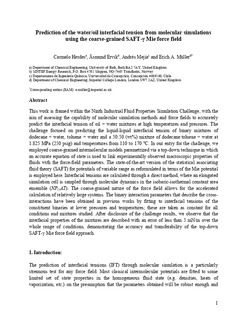| dc.contributor.author | Herdes, Carmelo | |
| dc.contributor.author | Ervik, Åsmund | |
| dc.contributor.author | Mejìa, Andrès | |
| dc.contributor.author | Müller, Erich A. | |
| dc.date.accessioned | 2019-10-03T12:50:27Z | |
| dc.date.available | 2019-10-03T12:50:27Z | |
| dc.date.created | 2017-06-26T12:41:30Z | |
| dc.date.issued | 2017 | |
| dc.identifier.issn | 0378-3812 | |
| dc.identifier.uri | http://hdl.handle.net/11250/2620110 | |
| dc.description.abstract | This work is framed within the Ninth Industrial Fluid Properties Simulation Challenge, with the aim of assessing the capability of molecular simulation methods and force fields to accurately predict the interfacial tension of oil + water mixtures at high temperatures and pressures. The challenge focused on predicting the liquid-liquid interfacial tension of binary mixtures of dodecane + water, toluene + water and a 50:50 (wt%) mixture of dodecane:toluene + water at 1.825 MPa (250 psig) and temperatures from 110 to 170 °C. In our entry for the challenge, we employed coarse-grained intermolecular models parametrized via a top-down technique in which an accurate equation of state is used to link experimentally observed macroscopic properties of fluids with the force-field parameters. The state-of-the-art version of the statistical associating fluid theory (SAFT) for potentials of variable range as reformulated in terms of the Mie potential is employed here. Interfacial tensions are calculated through a direct method, where an elongated simulation cell is sampled through molecular dynamics in the isobaric-isothermal constant area ensemble (NPzzAT). The coarse-grained nature of the force field allows for the accelerated calculation of relatively large systems. The binary interaction parameters that describe the cross-interactions have been obtained in previous works by fitting to interfacial tensions of the constituent binaries at lower pressures and temperatures; these are taken as constant for all conditions and mixtures studied. After disclosure of the challenge results, we observe that the interfacial properties of the mixtures are described with an error of less than 5 mN/m over the whole range of conditions, demonstrating the accuracy and transferability of the top-down SAFT-γ Mie force field approach. | nb_NO |
| dc.language.iso | eng | nb_NO |
| dc.publisher | Elsevier | nb_NO |
| dc.rights | Attribution-NonCommercial-NoDerivatives 4.0 Internasjonal | * |
| dc.rights.uri | http://creativecommons.org/licenses/by-nc-nd/4.0/deed.no | * |
| dc.title | Prediction of the water/oil interfacial tension from molecular simulations using the coarse-grained SAFT-γ Mie force field | nb_NO |
| dc.type | Journal article | nb_NO |
| dc.type | Peer reviewed | nb_NO |
| dc.description.version | acceptedVersion | nb_NO |
| dc.source.pagenumber | 9-15 | nb_NO |
| dc.source.volume | 476 | nb_NO |
| dc.source.journal | Fluid Phase Equilibria | nb_NO |
| dc.identifier.doi | 10.1016/j.fluid.2017.06.016 | |
| dc.identifier.cristin | 1478851 | |
| dc.relation.project | Norges forskningsråd: 206976 | nb_NO |
| cristin.unitcode | 7548,60,0,0 | |
| cristin.unitname | Gassteknologi | |
| cristin.ispublished | true | |
| cristin.fulltext | postprint | |
| cristin.qualitycode | 2 | |

